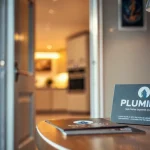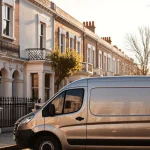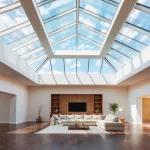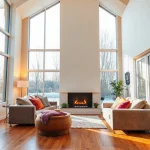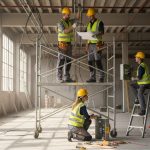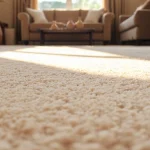Overview of Smart Home Technologies
Smart Home Technologies have grown significantly, offering various solutions that enhance comfort, security, and energy efficiency. This category includes devices like smart lighting, thermostats, and security systems, all of which aim to automate and simplify home operations. Integration of these technologies allows for single-platform control, enabling a streamlined user experience. For instance, a smart thermostat can not only learn heating patterns but also communicate with other devices, enhancing energy conservation.
Integrating smart home technologies into historical buildings, like those with Grade II Listed status, presents unique advantages. It enhances modern living convenience without compromising on the charm and character of older structures. Current trends in automation showcase voice-controlled assistants and sensors that adapt automatically to daily routines, embodying a seamless merging of traditional aesthetics with modern innovation.
Also to see : Top Strategies to Keep Your UK Basement Flat Mold-Free
Interestingly, automation is becoming more intuitive with artificial intelligence, allowing homes to become increasingly self-reliant and responsive. The benefits of this progression are manifold: increased security through integrated systems, improved energy efficiency with intelligent heating, and enhanced ambiance through customizable lighting. Smart home technologies have thus become indispensable in maintaining balance between historical integrity and contemporary practicality.
Legal Considerations for Listed Buildings
Navigating the realm of smart home technologies in Listed Buildings necessitates an understanding of various regulations and compliance requirements. In the UK, Grade II listed buildings are protected by strict laws aiming to conserve their historical significance. Any modifications, including smart technology installations, generally require specific permissions and consents from local planning authorities. Applying these regulations ensures the building’s character is respected, despite the introduction of modern conveniences.
Also read : Top Strategies for Maximizing Natural Light in Your UK Basement Conversion
To proceed with installations, particularly of smart elements, obtaining a Listed Building Consent becomes crucial. This consent not only assesses the impact of the proposed changes but also determines the methods of undertaking them to minimise disturbance to the building’s integrity. Understanding these regulatory landscapes can facilitate compliance while enhancing the building with contemporary technology.
The relevance of such compliance is evident in maintaining a balance between preserving architectural heritage and accommodating modern functionality. For instance, compatibility with traditional features might require customised solutions, ensuring that the integration of advanced systems does not disrupt the aesthetic or structural essence. Successfully marrying smart technologies with listed buildings contributes significantly to their upkeep, permitting their continued use in line with modern living standards.
Preservation Techniques for Historical Integrity
Balancing modern technology with the preservation of historical integrity is an art that requires careful attention and expertise. Preserving the historical aspects of Grade II listed buildings while integrating smart home technologies involves a few meticulous techniques. Primarily, consulting with preservation specialists ensures that any intervention respects the building’s original aesthetic and structural elements. These experts guide the adaptation of modern solutions without compromising the historic charm.
Case studies serve as a valuable resource in understanding successful methodologies in maintaining historical integrity during upgrades. Each project provides insights into the attachment of new systems, such as discreet wiring paths or reversible installations, minimizing physical alterations to the structure. For example, a Victorian-era home might use wireless technology to avoid intrusive cabling.
An emphasis on techniques such as customizing smart solutions tailored for compatibility with existing features is crucial. Utilizing period-appropriate materials and finishes can seamlessly blend technological improvements with historical aesthetics. Additionally, being attuned to preservation techniques often involves adapting existing technologies rather than introducing new ones, preserving the authenticity of the building while enhancing its functional capabilities. These strategies safeguard the historical value of structures while embracing the benefits of modern innovations.
Ideal Smart Home Solutions for Grade II Listed Buildings
Incorporating smart solutions into Grade II listed buildings involves balancing technological advancement with architectural preservation. Selecting the right technologies that ensure compatibility with historical structures is essential.
Smart Lighting Systems
Smart lighting offers both functional and aesthetic benefits. Technologies like wireless bulbs and motion sensors can illuminate period features without altering fixtures. These systems provide adjustable ambiance and energy efficiency without permanent installations, preserving the building’s character.
Smart Thermostats
Non-invasive thermostats, such as those using wireless control, are recommended to maintain structural integrity. These smart thermostats offer precise climate control, learning heating and cooling habits to optimize comfort while respecting the original architecture. They ensure energy efficiency without requiring extensive installation work.
Integrated Security Systems
For a Grade II listed building, security systems must be unobtrusive. Discreet cameras, sensors, and alarms can protect the property while honoring its architecture. Easily installed and removed, these solutions offer security without compromising historical aesthetics. Smart locks can enhance access control while integrating seamlessly with traditional doors.
These smart solutions not only enhance living convenience but also ensure the architectural charm of Grade II listed buildings is maintained. Selecting appropriate technologies respects historical aspects and seamlessly integrates with the structure’s existing features.
Installation Tips and Best Practices
Successful installation of smart home technologies in Grade II listed buildings involves thoughtful consideration of several factors, ensuring a seamless blend of modern convenience with historical charm. Initiating installations begins with meticulous planning, embracing best practices that include conducting a thorough assessment of the building’s existing infrastructure. Ensuring the compatibility of smart devices with antiquated systems is paramount to preserving architectural integrity.
Collaborating with professionals experienced in working with listed buildings is crucial. These experts provide invaluable insights into potential challenges and propose tailored solutions, ensuring installations are reversible and minimally invasive. Considering the building’s structural nuances, they can recommend appropriate methods that maintain aesthetic harmony while integrating advanced technologies.
Flexibility in choosing technology solutions cannot be overstressed. Opt for systems that offer adaptable features, enabling smooth future upgrades without additional alterations to the building. Smart lighting and thermostat options often include wireless versions, which reduce intrusive installations and preserve historical features.
Additionally, maintaining open communication with local conservation officers and planning authorities throughout the process is beneficial. This ensures compliance with regulations and helps avoid potential legal pitfalls. By embracing familiar and time-tested approaches, one can enhance a historical building’s functionality while safeguarding its authentic charm.
Challenges and Solutions in Integration
Incorporating smart home technologies into historical buildings, particularly Grade II Listed structures, brings forth a set of unique challenges. The primary obstacle is maintaining the delicate balance between modern conveniences and architectural preservation. This often involves addressing concerns such as aesthetic disruption and structural integrity.
To navigate these hurdles, innovative solutions have emerged. One approach is the development of wireless systems that reduce the need for invasive installations, offering a non-intrusive method for integrating technology. These solutions preserve the aesthetic and structural integrity of historical buildings.
Community engagement plays a crucial role in successful integrations. By involving local stakeholders and conservation officers, property owners ensure that installations align with both technological advantages and preservation standards. Feedback from these communities can guide adaptations and offer insights that enhance both functionality and compliance.
Another effective strategy is the employment of modular and reversible installation techniques. This allows homeowners to update technologies without causing permanent alterations to the structure. Integrating feedback from ongoing community engagement ensures sustainable and respectful enhancements, paving the way for smart, yet sensitive, integrations that honour historical significance.
Insightful Case Studies
Case Studies offer invaluable insights into the successful integration of smart home technologies within listed buildings. By examining real-world examples, we can glean vital lessons and recommendations for similar projects.
One notable example is a Georgian townhouse in Bath, where an innovative approach allowed for seamless integration of modern conveniences. A combination of wireless technology solutions, like smart thermostats and discreet lighting, preserved the integrity of the period features while enhancing the building’s functionality.
Interviews with experts involved in these projects provide firsthand insights. Architectural conservator, Sarah Williams, emphasized the importance of “non-invasive installations and maintaining reversible methods to ensure historical preservation.” Her insights highlight the significance of preserving authentic aesthetics while introducing modern solutions.
From another case in York, a Victorian property utilized solar panels strategically placed on hidden roofs, limiting visual impact while supporting sustainability. This approach demonstrates how environmental considerations can align with heritage preservation.
Lessons learned from these integrations stress the importance of early planning and collaboration with heritage specialists. Seeking advice from professionals familiar with historical contexts and smart technologies ensures a harmonious blend of old and new, safeguarding both functional advancements and architectural charm.
Future Trends in Smart Home Technology for Listed Buildings
Exploring the future trends in smart home technologies reveals exciting possibilities for listed buildings. As innovation continues, these buildings can benefit from emerging solutions that honor their historical context while optimizing convenience and functionality.
Emerging Technologies
Anticipated advancements include improvements in wireless systems and artificial intelligence, further reducing the need for invasive installations. This will ease integration into historic structures, preserving their aesthetic value. Another promising development is the growth of smart glass technologies. These can adjust transparency and provide temperature control, representing a minimalist approach that revolutionizes window management.
Sustainable Solutions
The incorporation of solar harvesting technologies could play a pivotal role. Solar panels are now being designed with flexible and low-impact forms, potentially aligning with conservation principles. These innovative solutions cater to energy efficiency while maintaining architectural integrity.
Adapting to Change
The shift towards adaptive smart systems—where devices learn and predict user behavior—indicates future innovation. These systems enable smart homes to respond to environmental changes with minimal human intervention, continuing to adapt without altering the building structure.
Future trends promise a dynamic intersection between preservation and modern technology, ensuring listed buildings remain iconic yet functional with emerging smart solutions.

